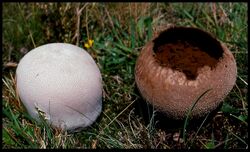Biology:Handkea
| Handkea | |
|---|---|

| |
| Handkea utriformis | |
| Scientific classification | |
| Kingdom: | |
| Division: | |
| Class: | Basidiomycetes
|
| Order: | |
| Family: | |
| Genus: | Handkea Kreisel
|
| Type species | |
| Handkea utriformis (Bull.) Kreisel
| |
Handkea is a genus of puffball mushrooms in the family Agaricaceae. In 1989, German mycologist Hanns Kreisel described the genus Handkea to include species of Calvatia with distinct microscopic features, including a unique type of capillitium (coarse thick-walled hyphae in the gleba), with curvy slits instead of the usual pores.[1] Although accepted by some authors,[2] the genus concept has been rejected by others.[3][4]
The genus name of Handkea is in honour of Horst-Herbert Handke (1913-2005), who was a German botanist and Professor at the University of Halle.[5]
Phylogenetic analyses published in 2008 shows that Handkea may be grouped in a clade along with species from several other genera, including Lycoperdon, Vascellum, Morganella, Bovistella, and Calvatia.[6]
Species
References
- ↑ Kreisel H. (1989). "Studies in the Calvatia complex (basidiomycetes)". Nova Hedwigia 48 (3–4): 281–96.
- ↑ British puffballs, earthstars and stinkhorns: an account of the British gasteroid fungi. Kew: Royal Botanic Gardens. 1995. ISBN 0-947643-81-8.
- ↑ Demoulin, V; Lange, M (1990). "Calvatia turneri (Ellis et Everh.) Demoulin et M. Lange, comb. nov., the correct name for C. tatrensis Hollós". Mycotaxon 38: 221–26.
- ↑ Demoulin V. (1971). "Le genre Lycoperdon en Europe et en Amérique du Nord. Etude taxonomique et phytogéographique". PhD. thesis, Université de Liège.
- ↑ Burkhardt, Lotte (2022) (in German) (pdf). Eine Enzyklopädie zu eponymischen Pflanzennamen. Berlin: Botanic Garden and Botanical Museum, Freie Universität Berlin. doi:10.3372/epolist2022. ISBN 978-3-946292-41-8. https://doi.org/10.3372/epolist2022. Retrieved January 27, 2022.
- ↑ "Phylogenetic relationships among species and genera of Lycoperdaceae based on ITS and LSU sequence data from north European taxa". Mycological Research 112 (Pt 1): 4–22. 2008. doi:10.1016/j.mycres.2007.10.018. PMID 18207380.
External links
- "Handkea Kreisel". Atlas of Living Australia. https://bie.ala.org.au/species/urn:lsid:indexfungorum.org:names:25306.
Wikidata ☰ Q5647449 entry
 |

